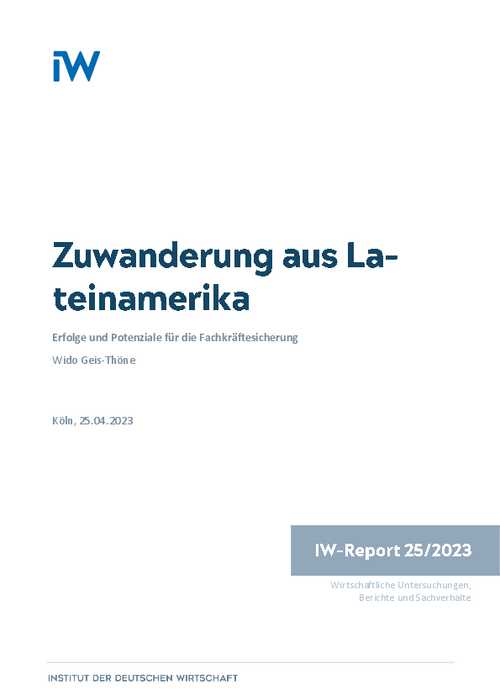Against the background of the baby boomers leaving the labour market, Germany will be increasingly dependent on skilled workers from abroad in the coming years in order to secure growth and prosperity.

Immigration from Latin America: Successes and potential for securing skilled workers

Against the background of the baby boomers leaving the labour market, Germany will be increasingly dependent on skilled workers from abroad in the coming years in order to secure growth and prosperity.
At the same time, demographic change is also progressing in the other EU countries, so that strong immigration can no longer be expected from here, at least on balance. Hence German migration policy must direct its focus to the non-European area. Here, preferably different regions should be addressed in order to avoid political or economic shifts in individual countries leading to sharp drops in employment-related immigration to Germany. One focus should be on the American countries south of the United States, which will be referred to as Latin America in the following.
Although this region is very large with a total area of 20.1 million square kilometres, it is only home to 654.1 million people, less than half as many as India with 1.40 billion. By far the largest and most populous country in the region is Brazil with 213.8 million inhabitants. Mexico follows in second place with 126.4 million inhabitants. Together, these two countries already account for 52.0 percent of Latin America's population. Adding the next three countries, Colombia, Argentina and Peru, one gets 71.9 per cent, despite the fact that the region comprises a total of 33 independent states. Though the smaller countries have only very limited potential for securing skilled labour in Germany, given their population size, they should not be completely disregarded when developing a corresponding strategy. Fortunately, Spanish is spoken in most of them, as well as in the large countries except Brazil, so that possibly the same advertising campaigns and information materials can be used. The basic conditions for increased skilled labour immigration to Germany are basically favourable in the Latin American countries. However, Germany is in competition there for people willing to migrate, especially with the United States, where already strong ethnic communities exist. Hence, a sophisticated recruitment strategy is likely to be necessary in order to achieve larger numbers of immigrants.
Germany has already been very successful in this area in recent years. The number of Latin Americans in the country rose from 108,100 to 168,300 between 31 December 2011 and 31 December 2021, and at the same time the share of employees subject to social insurance contributions among the 15- to 64-year-old Latin Americans increased from 28.3 per cent to 51.5 per cent. In addition, with a share of 38.9 percent in June 2022, they were much more likely to be employed in expert or specialist occupations, which usually require a university degree or advanced vocational degree to master craftsman and the like, than the domestic workforce with only 29.7 percent. As well against the backdrop of a more frequent industry affiliation in the ICT sector and health and social services, Latin Americans in Germany are already making a particularly large contribution to securing skilled labour. This means that there is currently hardly any need for action regarding their integration and the major challenge lies in attracting more people to move to Germany. In addition to simplifying the entry process, this also requires approaching people who are eligible for skilled labour immigration in a targeted, promotional way, as has already been done in recent years by the "Make it in Germany" online portal, particularly in Brazil, Mexico, Colombia and Argentina.

Immigration from Latin America: Successes and potential for securing skilled workers

More on the topic

Record immigration not only due to flight from Ukraine
In 2022, more people immigrated to Germany than ever before in the history of the Federal Republic. Around 1.46 million more people moved here than left the country, which is more than a quarter more than the previous record of 1.14 million from 2015.
IW
Immigration from Southeast Asia: Success and potential for securing skilled workers
In the coming years, Germany will be increasingly dependent on skilled workers from abroad in order to avoid that gaps in the labour market caused by the retirement of the baby boomers will jeopardise growth and prosperity.
IW